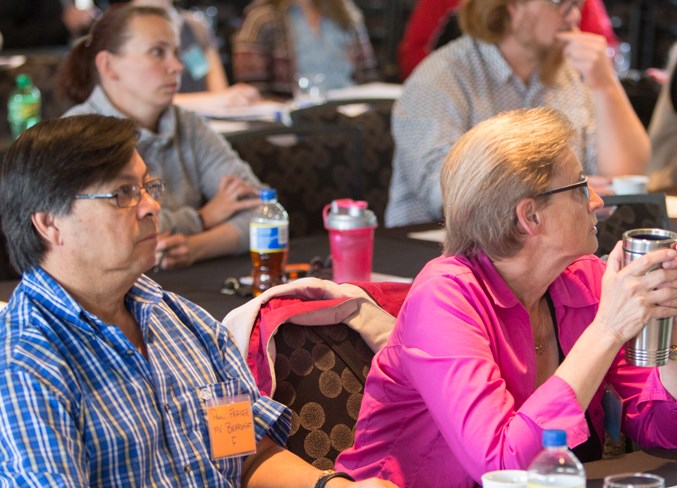Dozens of wildlife experts from across the province and beyond attended last week’s three-day provincial BearSmart workshop at the Sundre Golf Course and surrounding area.
BearSmart is a provincial government program that is delivered in different ways in different communities. In this region, Mountain View BearSmart Society focuses on education and awareness, and is a liaison with landowners and other stakeholders.
Held annually at various locations in the province, the 2018 Sundre workshop also included a number of field trips to district properties.
The overall focus of the workshop was information sharing and finding ways to prevent human-bear conflicts, said wildlife biologist Chiarastella Feder, who was one of the organizers and speakers at the event.
“The aim is to bring all the community-based groups together and discuss the progress made during the year, and the challenges and things like that,” said Feder.
“BearSmart programs can work so differently in so many areas depending on the necessities of that specific area. One of the main goals of the workshop is to find common threads that we have and how can we move the program forward at the provincial level.
“The idea is to bring people together and share ideas and help each other. We have different expertise to bring together.”
Numerous experts spoke during the workshop, outlining their respective experiences.
Darren McInnes, a Fish and Wildlife officer based in Sundre, said most of the bear conflicts he sees involve landowners.
“We deal with quite a few problems here just because of the area we are in, situated in the heart of bear and cougar country,” said McInnes. “We have a lot of bears, both black and Grizzlies, and cougars.
“We deal with conflicts and the bulk are landowner conflicts. This is farmers and ranchers with either predation, sheep or cattle being killed by bears, or especially in the fall, grain bins (being broken into).”
Experience has shown that attractant (such as grain and livestock carcass) management is one of the best ways to ensure that bears don’t become a problem, he said.
“Now that we’ve really started to manage attractants and put the onus on the landowner, the calls have gone done and the problems have gone down,” he said.
“The majority of people are pretty receptive to attractant management because it is simple and it works.”
Officers can use a variety of methods to deal with problem bears, he said.
“We might use rubber bullets, paintball guns, our sirens, anything to get it moving and make it feel it is not welcome here,” he said.
There is a special provincial team to deal with Grizzly bears, he said.
Paul Frame, a provincial carnivore specialist, outlined some of the history of the provincial BearSmart program, which started in 2006.
“The impetus for BearSmart was to keep people and bears safe on the landscape,” said Frame. “We want to hedge on the side of public safety. The public safety concern is what we want to address.”
Grizzly bear recovery strategies now in place include reducing human-caused mortality, reducing human-bear conflicts, managing attractants, improving education and outreach, identifying, managing and maintaining habitat, and improving inter-jurisdictional communication, he said.
Challenges facing BearSmart include maintaining volunteer programs, maintaining consistent funding, and dealing with bureaucratic processes, he said.
Tony Bruder, with the Waterton Biosphere Reservation Association, spoke about attractant management efforts now underway in southern Alberta, including the use of (non-lethal) electric fencing to keep bears out of grain bins.
Workshop participants took part in a tour of Elkton and Water Valley projects aimed at reducing human-bear conflicts.
Other speakers at the workshop included officials with the Mountain View BearSmart Society; Mark Heckbert, provincial wildlife conflict specialist; Marty Winchell with Clearwater County; Jay Honeyman with the BearSmart program South Saskatchewan region; Nick De Ruyter with the Wildsmart program in Canmore; and Mike Badr, provincial wildlife conflict manager in B.C.
Mountain View County councillor Greg Harris also attended the workshop.
Ensuring that bears and humans can share the landscape safely is in everyone’s best interest, said Feder.
“Mainly the idea is to make the community safer, certainly for the bears, but most specifically for the benefit of people,” said Feder. “Large predators have a place in our landscape.”



